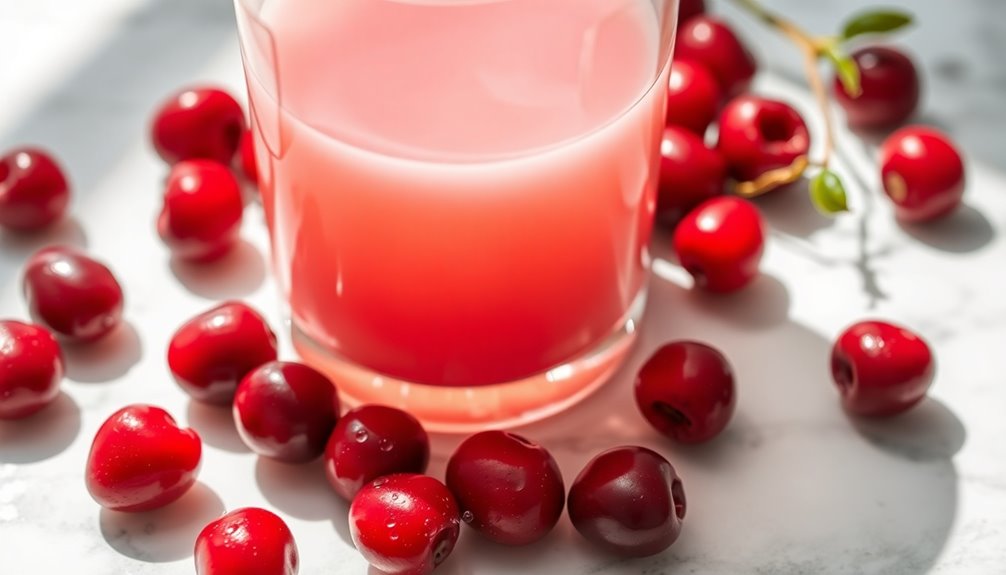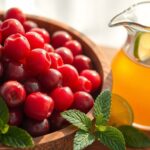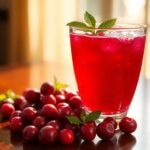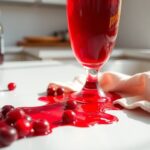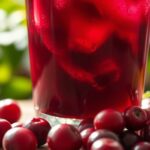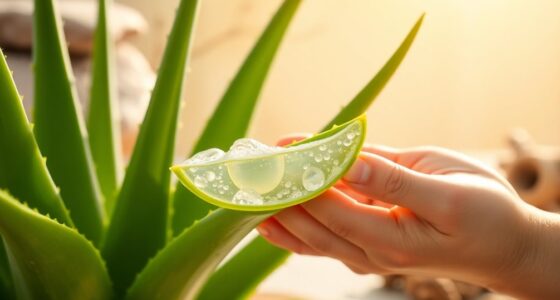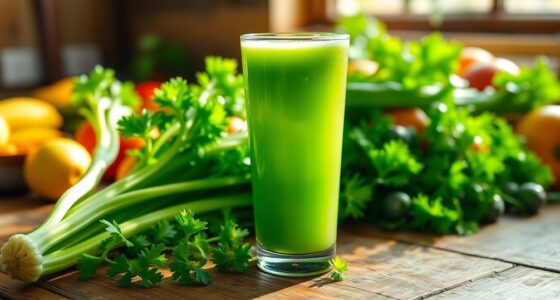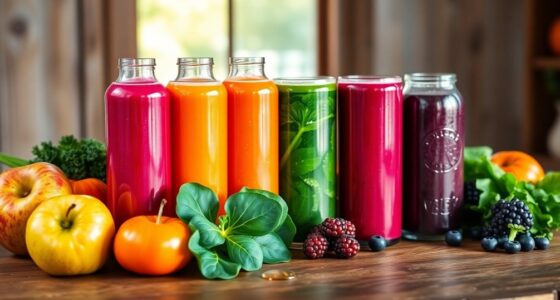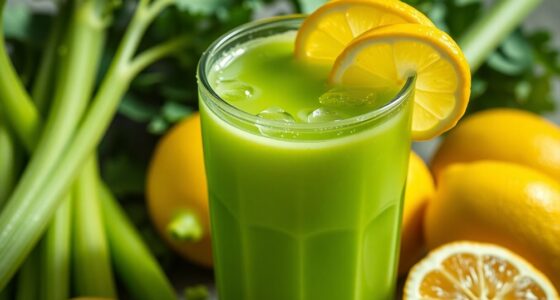Cranberry juice is white because it's made from under-ripened cranberries harvested early in the season. These berries have a lighter hue and offer a subtly sweet flavor compared to their fully mature red counterparts. The unique color comes from the absence of anthocyanins, which develop as cranberries ripen. This special juice also boasts a range of health benefits. If you're curious about what else sets white cranberry juice apart, there's much more to discover!
Key Takeaways
- White cranberry juice comes from under-ripened cranberries, harvested early in the season, resulting in a lighter hue.
- The color difference is primarily due to anthocyanins, which change with pH levels during ripening.
- White cranberries yield a milder flavor profile compared to the bold taste of fully ripe red cranberries.
- Limited quantities of white cranberries contribute to the exclusivity and unique appeal of white cranberry products.
- Processing techniques, such as early harvest and specific extraction methods, influence the final color and quality of the juice.
The Science Behind Cranberry Color
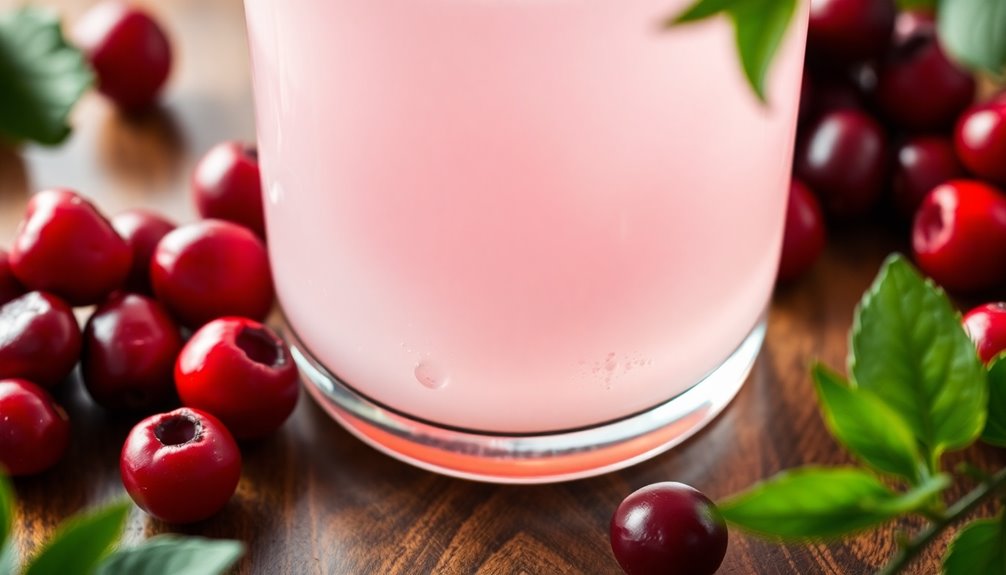
When you think about cranberry juice, the vibrant red color likely comes to mind, but there's a fascinating science behind both red and white varieties.
White cranberry juice comes from under-ripened cranberries harvested early in the season, before they develop their signature red hue. The color difference stems from anthocyanins, pigments that shift with pH levels. This means that while red cranberries yield a bold juice, white cranberries produce a paler, milder drink with a less tart flavor profile.
Additionally, processing techniques like activated carbon adsorption can modify juice color, but they must balance flavor and legal regulations.
Due to specific harvesting practices and limited availability, white cranberry juice remains a unique and often less accessible option compared to its red counterpart.
Understanding White Cranberries
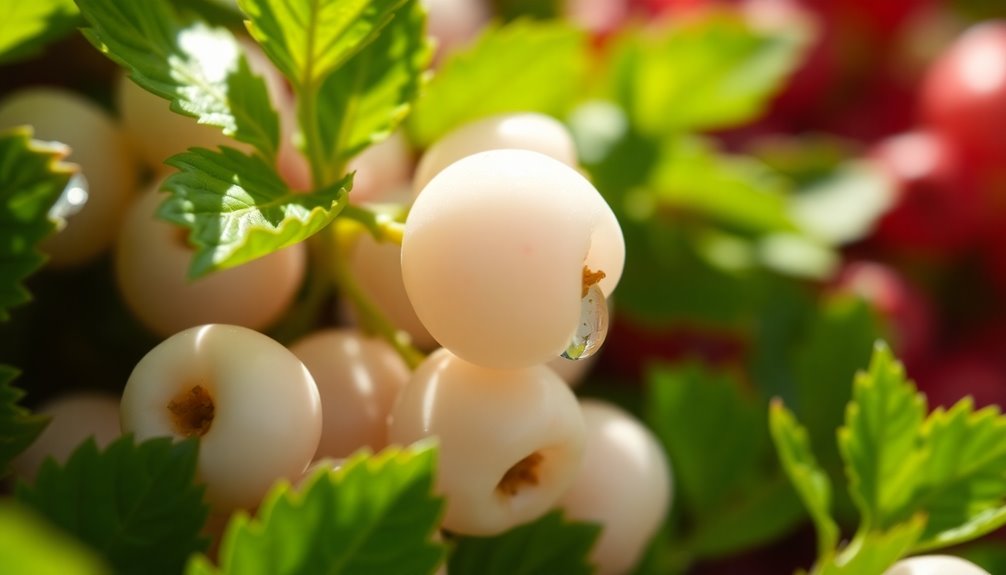
When you think about cranberries, you might picture the deep red variety, but white cranberries offer a fascinating twist.
These unripe berries are harvested early, giving them a light color and unique flavor that can enhance your drinks.
Let's explore their characteristics, harvesting process, and nutritional benefits.
White Cranberry Characteristics
Although often overlooked, white cranberries offer a unique perspective on this beloved fruit.
These under-ripened berries are harvested before they reach full maturity, giving them their distinct pale color. You'll notice that the juice extracted from white cranberries is lighter in hue compared to traditional red cranberry juice, making it visually appealing.
One of the most notable white cranberry characteristics is their milder flavor profile; they're less tart and provide a subtly sweet taste that some prefer.
As these berries ripen, they change in color from white to light pink and eventually red.
Due to their early-season harvest, white cranberries are available in limited quantities, adding to their exclusivity as a processed product.
Harvesting Process Explained
Understanding the harvesting process of white cranberries reveals how these unique berries maintain their distinct characteristics. Unlike fully ripened red cranberries, white cranberries are picked while still unripe, typically in the early season. This timing results in their pale color and unique taste.
To harvest, farmers flood the cranberry fields, which helps detach the fresh cranberries from their vines, making collection easier. Because of their early harvest, these berries are mostly found in limited processed products.
The juice extracted from white cranberries showcases a lighter color and different flavor profile compared to the juice from fully ripened red cranberries. This harvesting technique is essential for appreciating their distinct qualities and understanding their limited availability in the market.
Nutritional Benefits Overview
While you might not see white cranberries as often as their red counterparts, they pack a punch regarding nutritional benefits. These under ripened berries are rich in antioxidants, particularly phenolic compounds, which offer anti-inflammatory and anti-cancer properties. Drinking white cranberry juice can support your immune function and digestive health thanks to essential nutrients like vitamin C and dietary fiber. Plus, the lower acidity of white cranberry juice makes it gentler on your stomach while still delivering similar health benefits as traditional cranberry juice.
| Nutrient | Benefit |
|---|---|
| Vitamin C | Boosts immune function |
| Dietary Fiber | Aids digestion |
| Antioxidants | Reduces inflammation and cancer risk |
Processing Techniques and Their Effects
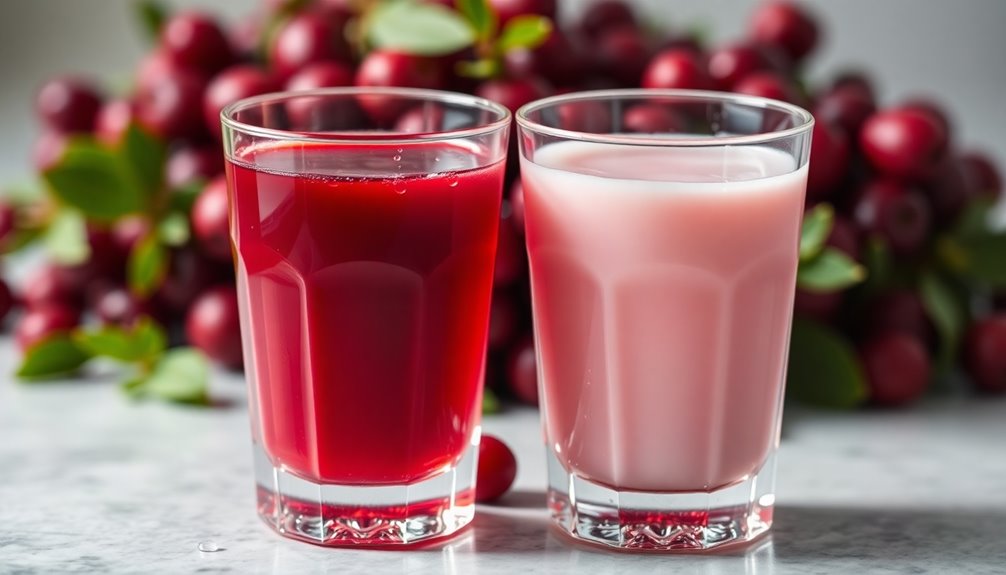
Processing techniques substantially influence the color and quality of cranberry juice, affecting everything from consumer appeal to legal classifications.
When you're enjoying a glass of white cranberry juice, you mightn't realize how much these methods shape its appearance and taste.
- White cranberries are harvested while under ripe.
- Activated carbon adsorption can lighten juice color.
- pH-altering agents may modify hue but face strict regulations.
- Processing techniques can change product chemistry.
- Supplier coordination is essential for ideal outcomes.
Understanding these processing techniques helps you appreciate the uniqueness of white cranberry juice. Additionally, the impact of investment regulations highlights how various factors can shape product offerings in the market.
Each step in production not only affects color but can also impact the legal definitions of what you're drinking, ensuring you're informed with every sip.
The Role of Ph in Cranberry Juice Color
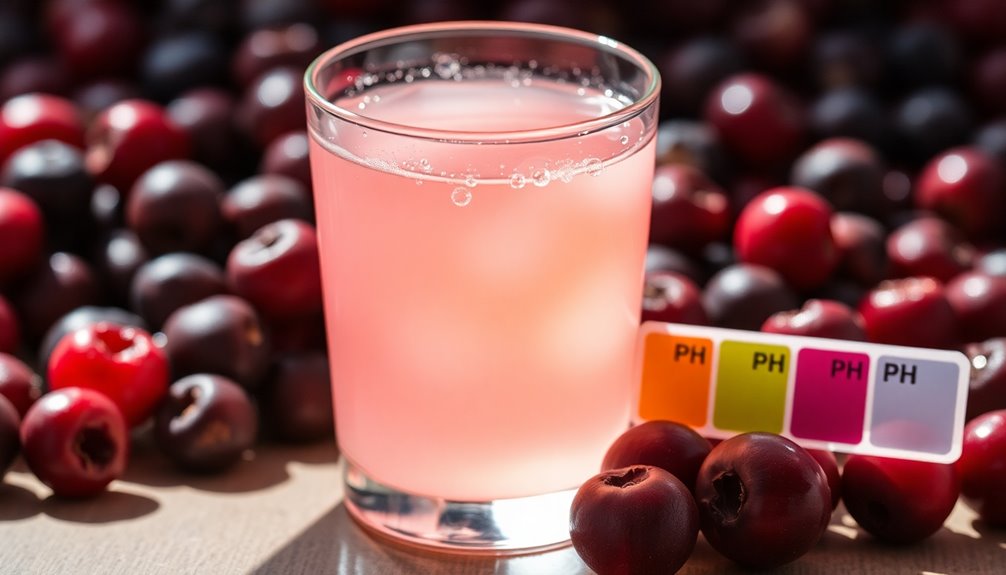
The pH level of cranberry juice plays an essential role in determining its color.
When you lower the pH, anthocyanins give the juice a vibrant red hue, while a higher pH can lighten it considerably.
Understanding these pH modifications helps in crafting cranberry products that appeal to consumers visually.
Anthocyanin Color Variation
As you explore cranberry juice, you'll notice that its vibrant color is largely shaped by the pH levels, which influence the anthocyanin pigments responsible for its hues.
This anthocyanin color variation is fascinating, as slight changes in acidity can lead to a spectrum of colors.
Consider these key points:
- Lower pH (more acidic) yields a redder juice.
- Higher pH (less acidic) shifts the color to purple.
- White cranberries produce lighter juice due to fewer anthocyanins.
- pH-altering agents can change juice color, but are strictly regulated.
- Activated carbon can lighten juice without compromising taste.
Understanding these factors helps you appreciate the chemistry behind your favorite cranberry juice!
Ph Modifications Impact Color
While exploring the vibrant world of cranberry juice, you'll find that pH modifications play a significant role in determining its color. The anthocyanins present in the berries react to changes in acidity or alkalinity, with lower pH levels producing a redder hue.
Conversely, raising the pH makes the juice appear more purple. You can influence this transformation by adding substances like baking soda, which increases the pH and alters the color.
However, it's essential to recognize that legal restrictions limit the use of certain pH-altering agents, like sodium hydroxide, in food products. Ensuring that any modifications maintain the juice's flavor and comply with local regulations is vital for safety and marketability.
Nutritional Benefits of Cranberries
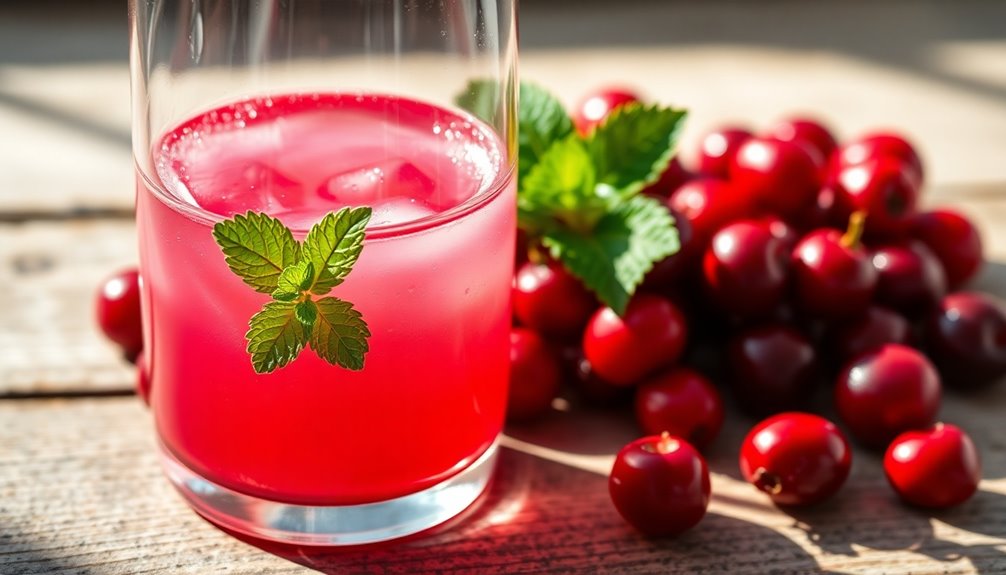
Cranberries pack a powerful punch when it comes to nutritional benefits, making them an excellent addition to your diet.
They're not just a tasty treat; they're also low in calories—only about 50 per cup—making them a healthy snack option.
Here are some key benefits of cranberries:
- Rich in antioxidants like vitamin C and phenolic compounds
- Good source of dietary fiber, aiding digestion with about 4 grams per cup
- May help prevent urinary tract infections by reducing bacterial adhesion
- Contains essential nutrients such as manganese, vitamin E, and vitamin K
- A delicious alternative to sugary beverages like white grape juice
Incorporating cranberries into your meals can boost your overall health and wellness!
The Impact of Additives on Juice Appearance
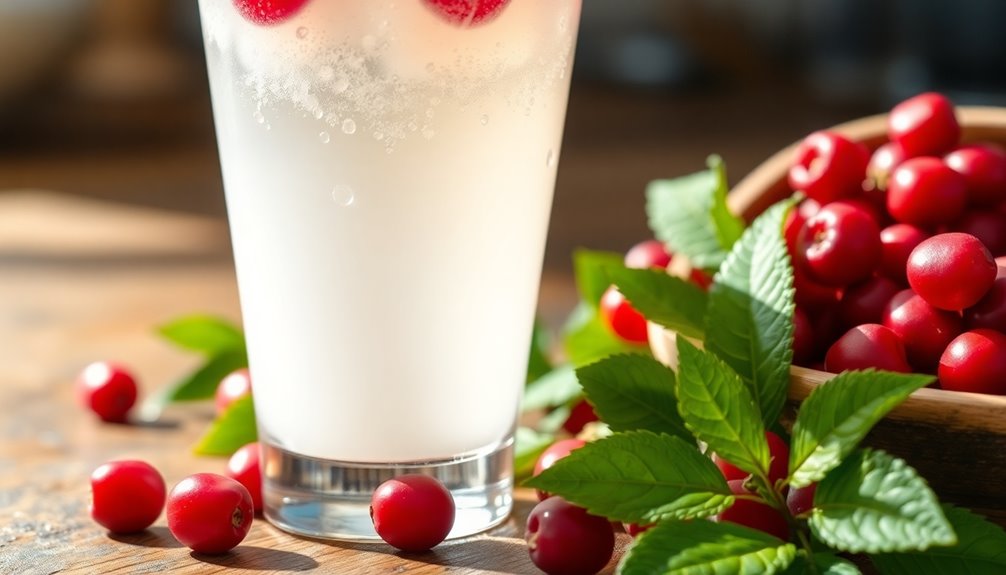
When you consider the appearance of cranberry juice, you'll find that the color is markedly influenced by additives and processing techniques.
One significant factor is the presence of anthocyanins, which can change based on the juice's pH level. Additives like sodium hydroxide can raise the pH, potentially altering the juice's color, though their use is strictly regulated.
Another method, activated carbon adsorption, can lighten the juice but might affect its flavor and aroma.
The choices you make regarding additives also impact the legal classification and marketability of the juice.
Understanding how these additives affect appearance is essential for compliance with local regulations while achieving the visual appeal you want for your cranberry juice product.
Seasonal Variations in Cranberry Juice

The color of cranberry juice isn't just about additives; it also varies seasonally, reflecting the natural cycles of harvesting.
White cranberry juice, made from under-ripened cranberries, is typically harvested early in the season. This juice is paler due to lower levels of anthocyanins.
Seasonal variations in production impact its availability, making it a limited crop.
Here are some key points about seasonal variations:
- White cranberries are harvested before they fully ripen.
- Juice color reflects the pH levels, with white juice having a higher pH.
- Demand for white cranberry juice peaks during holidays.
- Production schedules shift throughout the year to meet this demand.
- Availability can fluctuate, affecting what you find on store shelves.
Exploring Cranberry Juice Recipes
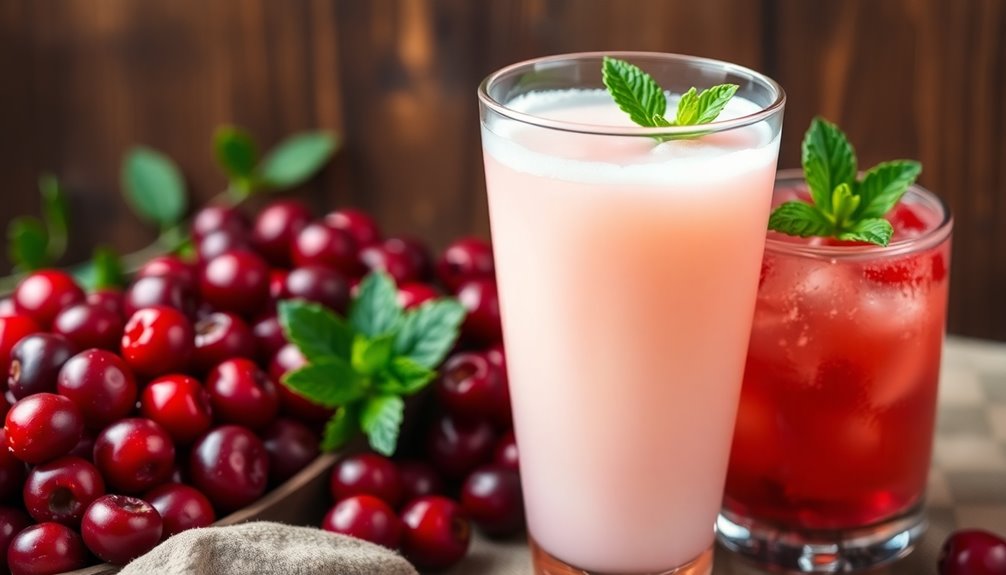
Have you ever wondered how to elevate your drinks and dishes with the unique flavor of white cranberry juice? Exploring cranberry juice recipes opens up a world of culinary creativity. From refreshing cocktails to tangy marinades, the versatility of white cranberry juice can transform ordinary meals into extraordinary experiences. Whether you’re crafting a zesty spritzer or a delicious glaze, the subtle sweetness and tartness of this juice offer a delightful twist. If you’re curious about pairing flavors, you might ask, ‘what is cranberry juice and vodka‘—a classic combination that showcases the juice’s ability to enhance drinks with a vibrant, fruity essence. In addition to its unique flavor, white cranberry juice also brings a plethora of health benefits to your culinary creations. When combined with vodka, the blend not only creates a deliciously refreshing drink but also offers a low-calorie option that’s perfect for social gatherings. Curious about the potential advantages? Delve into the cranberry juice and vodka benefits to discover how this delightful combination can support your wellness goals while still satisfying your taste buds.
For a revitalizing drink, mix white cranberry juice with strawberry syrup to create a delightful DIY Pink Drink. If you're in the mood for cocktails, try a Cranberry Manhattan; the white juice adds a seasonal twist to this classic.
You can also experiment by mixing it with soda or other fruity flavors, which can lead to fun activities like the "Dancing Cranberries" experiment that showcases buoyancy. Incorporating white cranberry juice in your dishes not only enhances flavor but also helps you enjoy the health benefits of cranberries.
Make this delicious!
The Future of Cranberry Juice Products
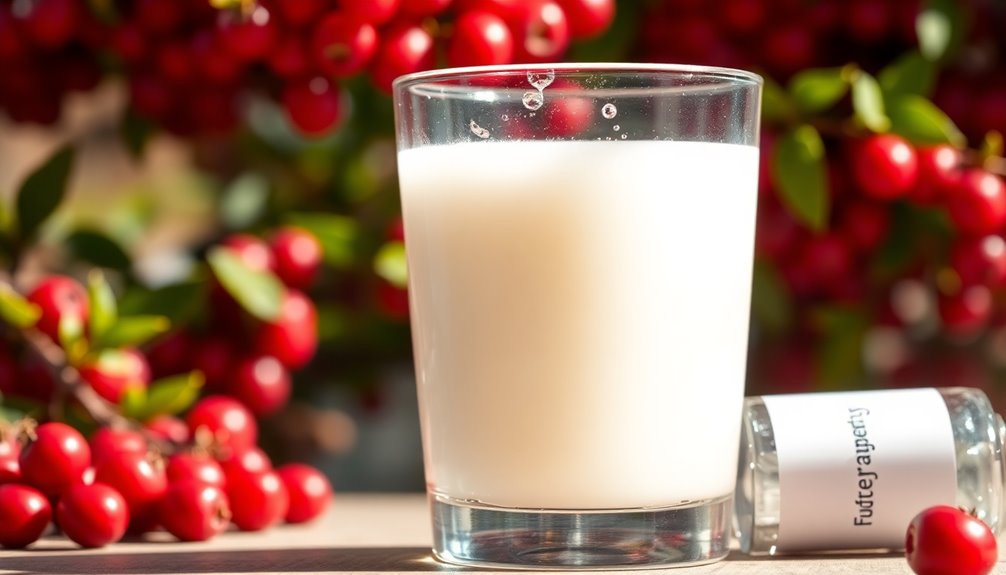
As you explore new ways to use cranberry juice in recipes, consider what lies ahead for cranberry juice products. The future looks promising, especially with the rising interest in white cranberry juice, made from under-ripened cranberries. This variant offers a unique flavor and a lighter color.
Here are some trends to watch:
- Increased demand for white cranberry juice
- Innovative processing techniques for visual appeal
- Regulatory compliance as a priority
- Health-focused products with no added sugars
- Collaborations with suppliers for sustainable sourcing
Frequently Asked Questions
Is There a Difference Between White Cranberry Juice and Regular Cranberry Juice?
Yes, there's a difference between white cranberry juice and regular cranberry juice.
White cranberry juice is made from under-ripened cranberries, giving it a lighter color and a milder, less tart flavor than the traditional red juice.
Both types offer similar health benefits, like antioxidants and vitamin C, but you might find white cranberry juice less common in stores.
If you prefer a subtler taste, you might enjoy trying the white variety!
What Is Responsible for the Color of Cranberry Juice?
The color of cranberry juice comes mainly from anthocyanins, which are pigments that react to the juice's pH level.
When you drink regular cranberry juice, you see a deep red hue due to fully ripened berries packed with these pigments.
If you encounter white cranberry juice, it's made from under-ripened cranberries that have lower anthocyanin levels, resulting in a lighter color.
Processing techniques can also alter the juice's appearance and flavor.
Why Are Some of My Cranberries White?
You might notice some of your cranberries are white, which can seem odd at first glance.
This happens because they're harvested while still unripe, lacking the vibrant red color you expect. As they ripen, they shift from white to red, affecting their juice's color and flavor.
These early-season, under-ripened cranberries offer a unique taste, so don't overlook them—they can add a different twist to your recipes and beverages!
Why Does White Cranberry Juice Taste Different?
White cranberry juice tastes different because it's made from under-ripened cranberries, which have a milder flavor profile.
You'll notice it's less tart and slightly sweeter than the red variety since the sugar and acid levels vary before ripening.
The juicing and filtration processes also play a role, resulting in a smoother taste.
This unique flavor can be a revitalizing alternative if you're looking for something less astringent.
Conclusion
As you sip your glass of cranberry juice, remember it's more than just a revitalizing drink; it's a vibrant tapestry woven from nature's mysteries. The brilliance of its hue, whether crimson or a soft white, tells tales of science and tradition. Each drop bursts with flavor and nutrients, beckoning you to explore its potential in your kitchen. So, whether you're blending cocktails or savoring it solo, let cranberry juice be a delightful adventure for your taste buds.
Cindy thoroughly researches juicing trends, techniques, and recipes to provide readers with practical advice and inspiration. Her writing style is accessible, engaging, and designed to make complex concepts easy to understand. Cindy’s dedication to promoting the advantages of juicing shines through her work, empowering readers to make positive changes in their lives through the simple act of juicing.

